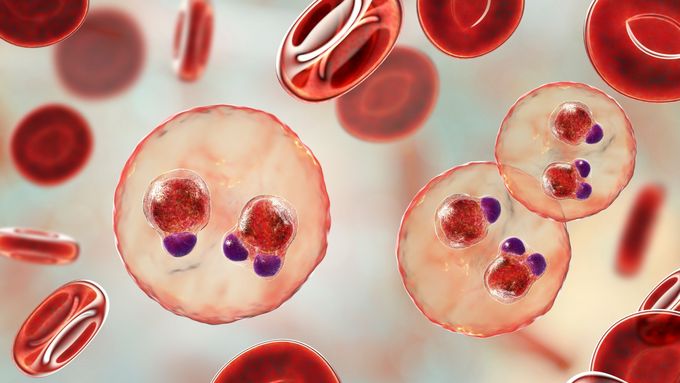New Discovery Unravels Malaria Invasion Mechanism
03.04.2024
A recent breakthrough sheds light on how the malaria parasite, Plasmodium falciparum, invades human red blood cells. The study, led by the Swiss Tropical and Public Health Institute (Swiss TPH) and Griffith University’s Institute for Glycomics, reveals the role of a sugar called sialic acid in this invasion process. The findings, published yesterday in Cell Reports, have major implications for malaria vaccine and drug development.

Malaria-infected red blood cells (Photo: AdobeStock)
With 249 million cases of malaria and 608,000 deaths in 2022, malaria has remained an intractable global health threat. The malaria parasite Plasmodium falciparum is the leading cause of severe malaria and is responsible for the largest portion of malaria deaths. All clinical symptoms of malaria are caused by the multiplication of malaria parasites in the red blood cells.
Key component found for malaria invasion
P. falciparum is known to invade human red blood cells, but the precise details of the targets that the parasite binds to has not been known to date. Although we know that the malaria protein, cystein-rich protective antigen (CyRPA), is essential for the invasion of red blood cells, its precise role in this process was not understood.
A multidisciplinary, collaborative research team from six institutions, led by investigators at Swiss TPH in Switzerland and Institute for Glycomics in Australia examined the binding properties of CyPRA. The researchers discovered that a sugar called sialic acid is a key component of the red blood cell surface that is recognized by the malaria parasite, and which is essential for the invasion process. The findings were published in the peer-reviewed journal Cell Reports.
“We are now demonstrating that P. falciparum CyRPA binds to a specific carbohydrate structure (glycan) present on the red blood cell surface. The CyRPA protein is highly adapted to bind to a glycan terminating with a sialic acid. The discovery of the key function of CyRPA in host cell invasion provides an explanation for the parasite inhibitory activity of CyRPA-specific antibodies” said Gerd Pluschke, Group Leader of Molecular Immunology at Swiss TPH, and co-corresponding author of the publication.
Malaria parasite adapted to humans
“Humans differ from other primates because they can only produce one type of sialic acid, called Neu5Ac. This genetic difference between humans and closely related primates has long been proposed to contribute to the species-specific targeting of malaria parasites. In this study, we show that the human form of sialic acid, Neu5Ac, is strongly preferred by the human-specific malaria parasite P. falciparum, and may explain the adaptation of this parasite to humans,” said Michael Jennings, Acting Director of the Institute for Glycomics, and co-corresponding author of the paper.
Implications for vaccine and drug development
Vaccines targeting the P. falciparum pre-erythrocytic stages are registered for use. However, they only show moderate levels of efficacy. There is no registered vaccine against the blood stage of malaria, but there is intensive research on blood stage vaccines. “The discovery of the key function of CyRPA in host cell invasion strongly supports the concept to clinically test CyRPA as a blood stage vaccine target,” said Pluschke.
Moreover, as the emergence of drug resistance in the parasites that cause malaria is a major health threat, the study’s findings offer hope for new antimalarial drugs that are urgently needed. “The essential binding activity of CyRPA to a specific glycan also validates CyRPA as drug target, and we demonstrate that small molecule inhibitors that interfered with this function can inhibit malaria replication in our study,” said Jennings.
Contact

Gerd Pluschke
Professor, PhD
Group Leader
+41612848235
,
-
gerd.pluschke@swisstph.ch
Stay connected
Subscribe to our newsletter and get all the latest research news, project updates, course and event listings from Swiss TPH.